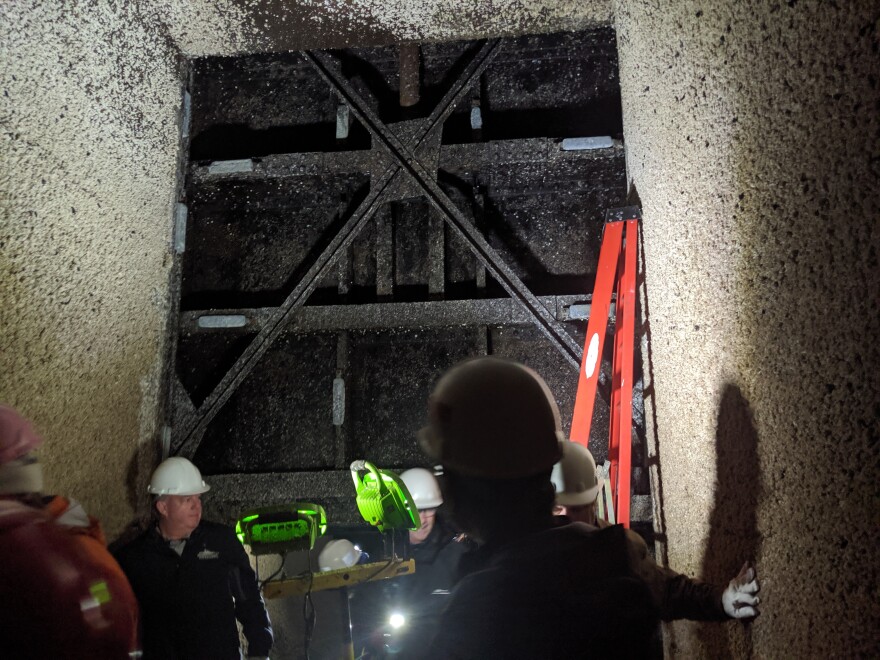Author’s note: This is one of those times when a story felt like a once-in-a-lifetime opportunity. And as a new resident of Ballard, what better way to see the neighborhood’s Hiram M. Chittenden Locks for the first time than to journey inside their walls? I jumped on the opportunity to join a tour through the large lock in October, after it was emptied for maintenance. The locks are more than 100 years old and when you find out that many of its components are just as old, it’s clear this mammoth thing is an engineering marvel. As I reveled in the sheer size of the towering locks and how they operate, I also learned that the U.S. Army Corps of Engineers faces a lot of challenges with trying to secure funding to maintain them. (This story originally aired Dec. 3.)
One of the chambers in the Ballard Locks that connects ships with Puget Sound is closed until December for much needed maintenance.
The cavernous chamber is now completely empty — aside from a thick layer of barnacles, shells and seaweed. When it's in operation, it connects large ships to the Puget Sound from Salmon Bay. It smells strongly of low tide, and gets worse the deeper into the lock we go.
"One thing I like to point out — right now, you're in the chamber. That's a big accomplishment, and you're not in a boat, so that's pretty cool," said Jon Hofstra, operations project manager for the U.S. Army Corps of Engineers, which operates the locks.
Hofstra brings us to one openings in the chamber's towering walls. It leads to a tunnel that's about 800 feet long. That's long enough to fit the Space Needle, with room to spare.
"Right now, we're in what we call one of the filling culverts," Hofstra said. "This is where the water is flowing when we raise and lower the large lock chamber."
Crews are replacing the parts that control how water flows through here. They're called "Stoney gate valves" and they're lifted up and down to change the water level of the chamber. Bill Dowell with the U.S. Army Corps of Engineers said this is the first time the valves have been fully replaced since the locks opened more than 100 years ago.

"This has never been done before," Dowell said. "We don't really know what we're going to run into so a 45-day closure, while we know it affects our customers, our stakeholders, the commerce that comes through here. It's gotta get done."
The Army Corps relies entirely on federal funding to do work on the locks. And it's important that the locks are kept up to date, because they control the levels of lakes Union and Washington. Changing these levels would affect miles of shoreline, and the floating bridges of state Route 520 and Interstate 90. Dowell said they have to decide what projects to prioritize long before they ask for funding.
"It isn't we just go in tomorrow and say, 'We need $10 million to put new gates in.' It takes years to get that taken care of," Dowell said. "And we compete with the entire nation."
The large chamber is closed and emptied each year for regular maintenance. But this closure is lasting about a month longer. The chamber is scheduled to reopen Dec. 3. The smaller chamber, which fits vessels up to 28 feet wide and 123 feet long, will stay open during this time. The large chamber will be closed a few more times between 2020 and 2021, so that all six valves can be replaced.
"The new ones, which will benefit salmon, is the fact that we can only open them up a certain amount, only let a certain amount of water through so you're not going to entrap fish at the entrance of the tunnel," Dowell said. He said the new valves also are designed to last just as long as the old ones, helping to keep the locks in operation for another hundred years.










